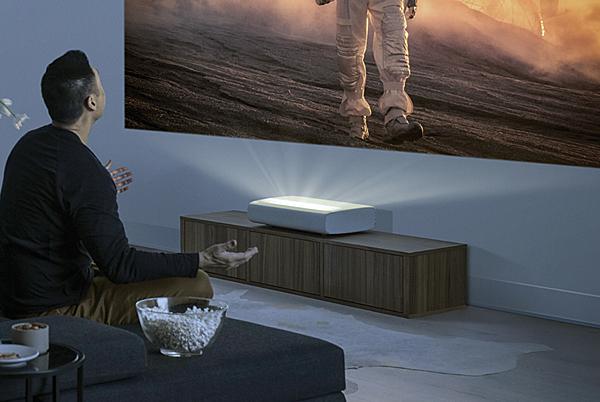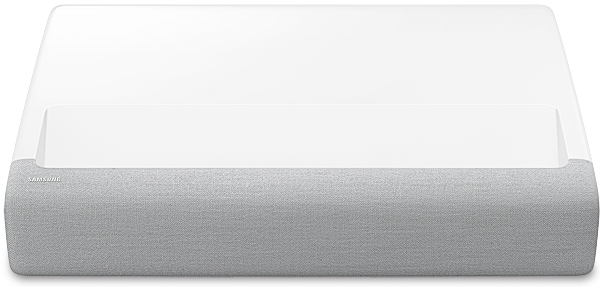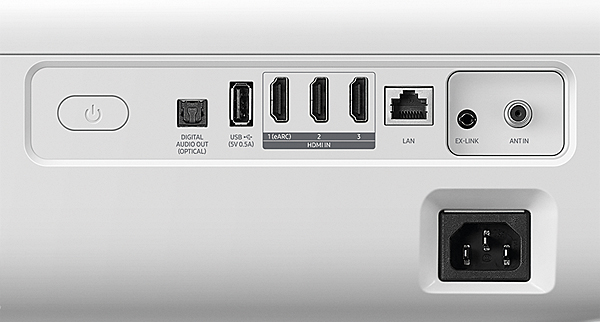Samsung The Premiere LSP9T 4K HDR UST laser projector review

 Samsung joins the UST PJ party with its feature-packed LSP9T. Steve Withers bathes in the glow of its triple-laser light source
Samsung joins the UST PJ party with its feature-packed LSP9T. Steve Withers bathes in the glow of its triple-laser light source
Samsung probably isn't the first name that springs to mind when thinking about projectors, but based on the company's new LSP9T 4K HDR beamer that might be about to change. Christened 'The Premiere', the brand backs the hyperbole with a seriously impressive set of specs that includes a three-colour laser light source, ultra-short-throw (UST) optics, beefy sound system, built-in tuners, and full Tizen smart platform.
The result is a projector that offers a genuine alternative to a bigscreen living room TV, arguably more so than any competitor. Naturally all this cutting-edge technology doesn't come cheap, with the LSP9T priced at £7,000. That might sound toppy, but don't forget it's capable of delivering an image up to 130in across – and good luck finding a TV that big for similar wonga.

Throwing A Picture Party
The main benefit of a UST projector is the ability to produce such a massive picture from an incredibly short throw distance. The LSP9T projects 100 inches from only 11cm, and can fill a 130in screen from just 24cm. Crucially, it does so without introducing optical aberrations or hotspotting.
Delivering these images is a light source composed of individual red, green and blue lasers, which results in a claimed brightness output of 2,800 Lumens, plus a 20,000-hour rated lifespan and improved stability compared to a normal projector lamp. Perhaps more importantly, it also generates a gigantic colour space. Samsung says the LSP9T can achieve 106 per cent of REC.2020 (a much wider space than the more commonly quoted DCI-P3). I actually measured it at 98 per cent of REC.2020, the largest gamut I've seen on any display… ever. A step-down model, the LSP7T (£4,000), delivers a more typical 83 per cent of the DCI-P3 colour space, from a single-laser light source, and maxes out image size at 120in.

Samsung applies additional technology to rein in the LSP9T's enormous gamut, with 16-bit colour mapping and powerful 4K upscaling for lower-resolution content. There are also a couple of features not currently found on any other projector: support for the dynamic metadata HDR10+ format, and a dedicated Filmmaker Mode to watch movies 'as the director intended'.
The projector has domesticated styling, with an elegantly curved chassis and neutral white finish. The front is completely covered in grey fabric, and there are cooling vents on either side. So despite being relatively large, this projector is surprisingly discreet, and from the front looks more like a soundbar on steroids.
This isn't far from the truth, actually, because inside you'll find a 4.2-channel speaker system with Acoustic Beam technology running off a claimed 40W of amplification. Normally I'd never recommend using a projector as an audio source (in part because of the usual distance between PJ and screen), but the LSP9T is an exception. It creates a better soundstage than most TVs, reinforcing its claim as a viable substitute.

Connections are all located on the side nearest the wall, allowing for tidier cable management. It's an impressive selection with three HDMI 2.0b inputs (one with eARC); terrestrial and satellite tuners; a USB port for multimedia playback and powering dongle-style streaming devices; an optical digital output; and an Ethernet port.
There's also integrated Wi-Fi, Bluetooth, and support for Apple's AirPlay 2. In fact, about the only hookup missing on the LSP9T is a 12V trigger output, which is a shame because it means you can't use the projector to activate a motorised screen. As for other missing features, there's no backlight on the otherwise intuitive remote and no support for 3D either. But that's about it, and in all other respects you won't find a better specified projector.
Making Moves
Installation is straightforward: place the projector on a flat surface parallel to the wall, then physically move it forwards or backwards to change image size, and left or right to centre it. You focus the image using the motorised control in the menu system, but try to avoid the keystone adjustment if possible – it will introduce scaling artefacts and rob the image of fine detail.
 |
Home Cinema Choice #351 is on sale now, featuring: Samsung S95D flagship OLED TV; Ascendo loudspeakers; Pioneer VSA-LX805 AV receiver; UST projector roundup; 2024’s summer movies; Conan 4K; and more
|























































